
The Chrysomelinae are a subfamily of leaf beetles (Chrysomelidae), commonly known as broad-bodied leaf beetles or broad-shouldered leaf beetles. It includes some 3,000 species around the world.

The Eumolpinae are a subfamily of the leaf beetles, or Chrysomelidae. It is one of the largest subfamilies of leaf beetles, including more than 500 genera and 7000 species. They are oval, and convex in form, and measure up to 10 mm in size. Typical coloration for this subfamily of beetles ranges from bright yellow to dark red. Many species are iridescent or brilliantly metallic blue or green in appearance.
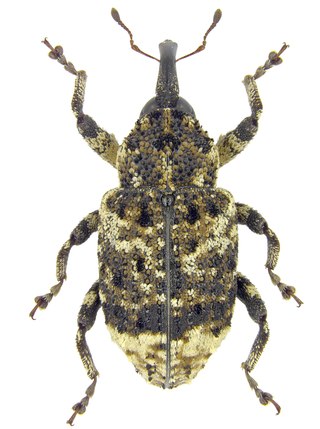
Cryptorhynchinae is a large subfamily of weevils (Curculionidae), with some 6000 species. They are found in most zoogeographic regions although they are most diverse in the Neotropics, Australia and Oceania.
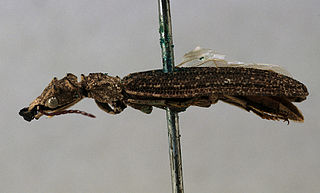
The Ommatidae are a family of beetles in the suborder Archostemata. The Ommatidae are considered the extant beetle family that has most ancestral characteristics. There are only seven extant species, confined to Australia and South America. However, the geographical distribution was much wider during the Mesozoic spanning across Eurasia and Australia, suggesting that they were widespread on Pangea. So far, over 26 extinct genera containing over 170 species of these beetles have been described. Three extant genera have been assigned to this family: Omma,Tetraphalerus and Beutelius. The family is considered to be a subfamily of Cupedidae by some authors, but have been found to be more closely related to Micromalthidae in molecular phylogenies. A close relationship with Micromalthidae is supported by several morphological characters, including those of the mandibles and male genitalia. Due to their rarity, their ecology is obscure, it is likely that their larvae feed on deadwood.
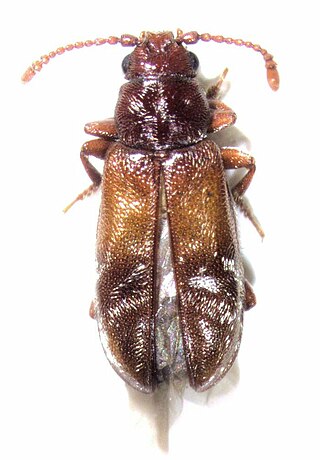
Cavognathidae is a family of beetles, in the superfamily Cucujoidea. It contains a single genus, Taphropiestes with around a dozen species known from South America, Australia and New Zealand. In Australian and New Zealand species adults and larvae have been found living in bird nests, but their ecology is unclear. They are possibly scavengers.
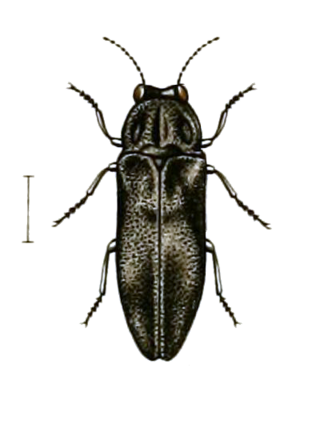
Aaaaba is a genus of beetles from the Buprestidae family. It inhabits locations along the east coast of Australia. It was described in 1864 by Achille Deyrolle as "Alcinous", a junior homonym of a genus of pycnogonids. In 2002, Charles Bellamy gave it the replacement name "Aaaba", but this proved to be another junior homonym, of a genus of sponges. In 2013, it was given a further replacement name, becoming Aaaaba.
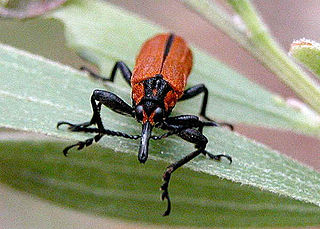
Rhinotia haemoptera, the red weevil, is a weevil species in the family Belidae found in Australia. They resemble net-winged beetles (Lycidae) in colour and are thought to mimic them.
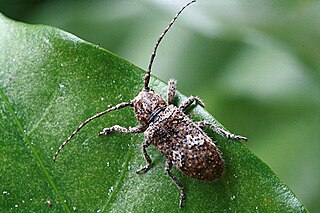
Rhytiphora bankii is a species of beetle in the family Cerambycidae. It was first described by Johan Christian Fabricius in 1775, under the genus Lamia. It is known from Australia, the Philippines, Borneo, Java, Micronesia, New Guinea, Hawaii, Moluccas, Sumatra, Vietnam, and has been introduced into Japan. The Australian species of Prosoplus were synonymised with Rhytiphora in 2013.
Rhytiphora lateralis is a species of beetle in the family Cerambycidae. It was described in 1858 by Francis Polkinghorne Pascoe as Symphyletes lateralis. It is known from Australia.

Holopsis is a genus of minute hooded beetles in the family Corylophidae. There are more than 30 described species in Holopsis, found throughout the world except Afrotropical and Antarctic regions.

Namunaria is a genus of cylindrical bark beetles in the family Zopheridae, first described by Edmund Reitter in 1882. There are at least two described species in Namunaria.

Synchita is a genus of cylindrical bark beetles in the family Zopheridae. There are about 20 described species in Synchita. The genus was first described in 1792 by Johann Christian Ludwig Hellwig.

Enneboeus is a genus of cryptic fungus beetles, family Archeocrypticidae. There are at least two described species in Enneboeus. It is found in the Neotropics.
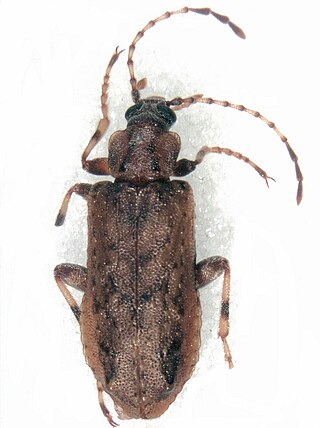
Promecheilidae is a family of beetles in the superfamily Tenebrionoidea. Perimylopidae is considered a synonym. They are found in southern South America and associated archipelagos like South Georgia and the Falklands, New Zealand and Tasmania. Some species are associated tree ferns and moss-covered dead wood, and other forested habitats, while others are associated with peat bogs, grasslands and coastal habitats. They are probably phytophagus, feeding on lichen, moss, and other plant material.
Zoltán Kaszab was a Hungarian entomologist and a specialist on the Tenebrionidae and Meloidae beetle families. He worked in the Hungarian Museum from 1950 and retired as its director.
Kyogle is a genus of insects in the family Staphylinidae, first described by Donald S. Chandler in 2001. The genus is found only in Australia, in New South Wales, South Australia, Victoria, Queensland and Tasmania.

Calomela bartoni is a beetle in the Chrysomelidae family, which is found in New South Wales and Victoria.

Coptocercus crucigerus is a species of beetle in the family Cerambycidae, first described by Frederick William Hope in 1842 as Stenochorus cruciger, from a specimen collected in Port Essington (Darwin). In 1929, Herbert James Carter assigned the species to the genus Coptocercus, and also synonymised it with Phoracantha politaPascoe, 1863.
Paroster arachnoides is water beetle in the Hydroporini tribe of the subfamily Hydroporinae in the Dytiscidae family. It was first described by Chris Watts and William Humphreys in 2004 as Nirripirti arachnoides. It was transferred to the genus, Paroster, in 2008 by Remko Leijs and Chris Watts.
Gondwanenneboeus is a genus in the beetle family, Archeocrypticidae, first described in 1984 by Zoltán Kaszab. There is just one species in the genus, Gondwanenneboeus minutissimus. The genus is named for Gondwana Land, and is native to Australia.
















